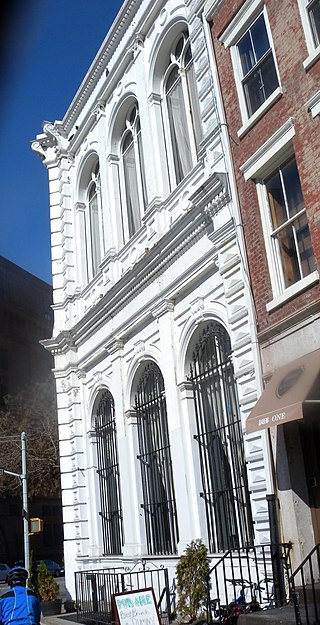
Fulton Ferry is a small area adjacent to Dumbo in the New York City borough of Brooklyn. The neighborhood is named for the Fulton Ferry, a prominent ferry line that crossed the East River between Manhattan and Brooklyn, and is also the name of the ferry slip on the Brooklyn side. The neighborhood is part of Brooklyn Community District 2.

This is intended to be a complete list of properties and districts listed on the National Register of Historic Places in Orleans County, New York. The locations of National Register properties and districts may be seen in a map by clicking on "Map of all coordinates". Two listings, the New York State Barge Canal and the Cobblestone Historic District, are further designated a National Historic Landmark.
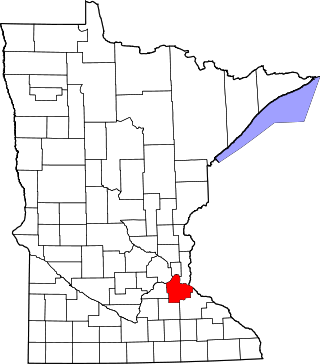
This is a list of the National Register of Historic Places listings in Dakota County, Minnesota. It is intended to be a complete list of the properties and districts on the National Register of Historic Places in Dakota County, Minnesota, United States. Dakota County is located in the southeastern part of the U.S. state of Minnesota, bounded on the northeast side by the Upper Mississippi River and on the northwest by the Minnesota River. The locations of National Register properties and districts for which the latitude and longitude coordinates are included below, may be seen in an online map.
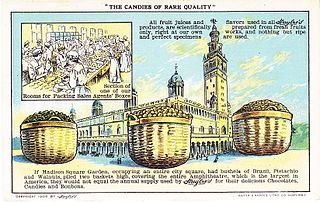
Huyler's was a candy and restaurant chain in the New York City metropolitan area that operated from 1874 to 1964, and for a time was the largest and most prominent chocolate maker in the United States. It was founded by John S. Huyler, who had grown up working in his father's bakery and ice cream store.
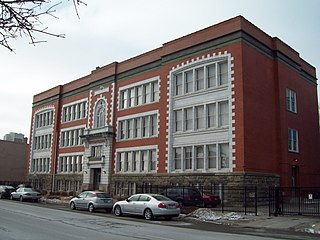
School 13, also known as Boys Vocational High School and Buffalo Alternative High School, is a historic school building located at Buffalo in Erie County, New York. It was built about 1915, and is a three-story, steel framed building sheathed in brick and terra cotta with Beaux-Arts style design elements. The "T"-shaped building housed administrative offices, classrooms, a gymnasium, swimming pool, and two-story auditorium. The building housed a school until 2003.

There are 75 properties listed on the National Register of Historic Places in Albany, New York, United States. Six are additionally designated as National Historic Landmarks (NHLs), the most of any city in the state after New York City. Another 14 are historic districts, for which 20 of the listings are also contributing properties. Two properties, both buildings, that had been listed in the past but have since been demolished have been delisted; one building that is also no longer extant remains listed.
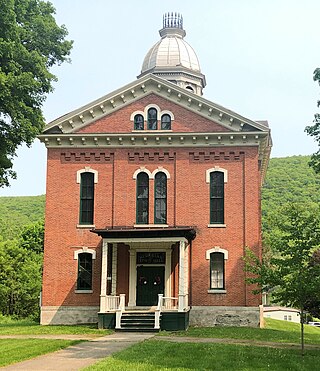
Naples Memorial Town Hall is a historic town hall located at Naples in Ontario County, New York. It was built in 1870–72 and is a lavish and imposing, two story rectangular brick building in the Italianate style. It was designed by A. J. Warner & Company, the Rochester partnership of A. J. Warner and Charles Coots. The town hall served as the center of the village and town's social and recreational activities until World War II. Between 1942 and 1972, the building was in private hands and served a variety of commercial and light industrial uses. In 1972, it was reacquired by the town and serves as a community center and host site for the annual Naples Grape Festival.

The Calumet is a historic commercial building located at Buffalo in Erie County, New York. It was designed in 1906, and is a three-story steel framed building covered in decorative architectural terra cotta. The distinctive glazed white and burnt sienna terra cotta is detailed with a centrally located reed or running stem and four leaves depicting the Calamus palm.
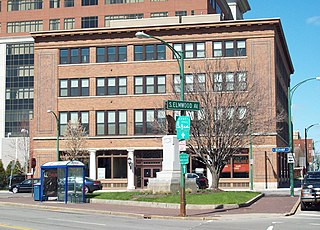
Robertson–Cataract Electric Building, also known as The Corn Exchange and 100 South, is a historic commercial building located in downtown Buffalo in Erie County, New York. It was built in 1915–1916, and is a four-story, five bay, reinforced concrete building faced in brick in the Renaissance Revival-style. The building was expanded in 1919. It features terra cotta and polychromatic brick details in hues of red, brown, and purple. It originally housed a retail showroom and warehouse space for the Robertson–Cataract Electric Co.
Esenwein & Johnnson was an architectural firm of Buffalo, New York.

Turner Brothers' Building–American Household Storage Company is a historic manufacturing and warehouse building located at Buffalo in Erie County, New York. The original section was built about 1848, and it is a four-story, wood frame, brick faced building in the Gothic Revival style. A six-story, two bay reinforced concrete addition was built in 1910. The building has three-story rear additions built in 1889 and 1940.

Dick Block is a historic commercial building located at North Tonawanda in Niagara County, New York. It was built in 1891 and is a three-story, three-bay, red brick building in the Romanesque Revival style. It features rounded windows and arches, rusticated stone detailing, and ornamental brickwork. The first floor storefronts were modernized about 1946, when the building was occupied by the Witkop and Holmes Company furniture store.
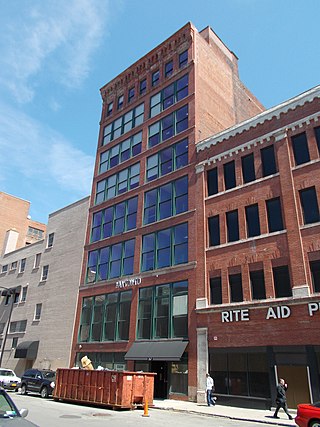
H. A. Meldrum Company Building is a historic department store building located at Buffalo in Erie County, New York. It was built about 1909 and is an eight-story, reinforced concrete commercial building with brick veneer walls. It was built as an addition to the Meldrum department store located at 460-470 Main Street. The H. A. Meldrum Company operated from 1897 to 1922. Its founder, Herbert Alexander Meldrum (1870-1960), was the son of Alexander Meldrum one of the founders of AM&A's.

Sibley and Holmwood Candy Factory and Witkop and Holmes Headquarters, also known as the Weed & Company Building, are two connected historic commercial buildings located in downtown Buffalo, Erie County, New York. The Sibley & Holmwood Candy Factory was built in 1896 and is a five-story, nine-bay-wide brick commercial block with late-Gothic detailing. It features Gothic window arches, decorative cast-iron columns on the storefront, and corbelled cornice. The Witkop & Holmes Headquarters was designed by the architectural firm Bethune, Bethune & Fuchs and built in 1901. It is a four-story, three-bay-wide brick commercial block. Both buildings have flat roofs. The building has been renovated to house loft apartments.
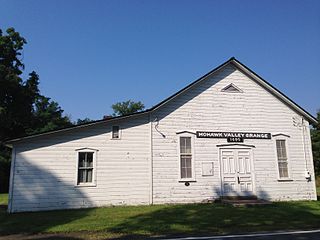
Mohawk Valley Grange Hall, also known as Union Hall and Moser Hall, is a historic Grange hall located near Grooms Corners, Saratoga County, New York. It was built in 1896, and is a 1 1/2-story, three bay by four bay, timber frame building. It sits on a dry lad stone foundation and has a steep gable roof. A one-story, shed roofed addition was built in 1934. The Grange purchased the building in 1931, and deeded the building to the Town of Clifton Park in 2004.
Nott Street School is a historic school building located at Schenectady, Schenectady County, New York. It was originally built in 1877 as a four-room school, with an eight classroom addition completed in 1909. It is a two-story, red brick building above a stone and concrete raised basement. The exterior has been painted since at least 1952. The building was used as a school until 1942, and has since been used for offices.
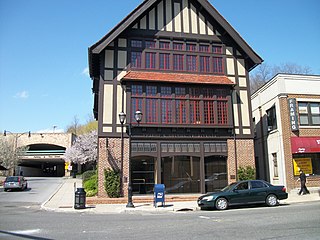
Old Glen Cove Post Office is a historic post office building located at Glen Cove in Nassau County, New York. It was designed by Stephen Voorhees, then with the architecture firm Eidlitz & McKenzie, and built in 1905. It is a three-story Tudor Revival influenced building. It measures 36 feet wide and 70 feet deep, with a rear addition constructed in 1915. The first floor facade is brick, while the two upper stories have applied timbers with stucco infill and French casement windows. The original Glen Cove Post Office building was replaced with the existing building on 2 Glen Cove Avenue in 1932. The old post office is now the headquarters of the Smiros & Smiros architectural firm.

The Christ Building is a historic commercial building located at 357-359 Sea Cliff Avenue in Sea Cliff, Nassau County, New York.
Christian Hess House and Shoemaker's Shop, also known as the Christian Hess Homestead and Weaver House, is a historic home and commercial building located at Schoharie, Schoharie County, New York. The house was built about 1783, and is a 1+1⁄2-story, banked, timber frame dwelling in a traditional New World Dutch style. A wing was added in 1977. Also on the property is a small shoemaker's shop, built about 1805. It is an "L"-shaped building with a gable roof.

Sinclair, Rooney & Co. Building, also known as the Remington Rand Building and Sperry-Rand Building, is a historic building located in downtown Buffalo, Erie County, New York. It was designed by the architecture firm Esenwein & Johnson and built between 1909 and 1911. The building is representative of Commercial Style architecture. The six-story, steel frame and concrete, "L"-shaped building is clad in yellow brick and consists of a rectangular main block, approximately 60-feet by 164-feet, with an extension of approximately 30-feet by 63-feet. It features brick pilasters that extend to the sixth floor, where they are capped by ornamental brick brackets and dentil molding below the roofline. It was built for Sinclair, Rooney, & Co., wholesale milliners, and later occupied by Remington Rand Corporation and its successor Sperry-Rand. The building housed offices and light manufacturing activities.





















